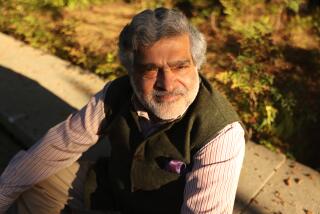John Lindsay; Ex-New York City Mayor, Civil Rights Crusader
- Share via
NEW YORK — John V. Lindsay, a former mayor of New York City who was an ardent champion of the cities and a tireless crusader for civil rights, died late Tuesday at Hilton Head Medical Center in South Carolina. He was 79.
The immediate cause of death was pneumonia, but Lindsay had been in poor health for some time, suffering from Parkinson’s disease and other illnesses.
Despite two strokes many years ago, Lindsay remained vitally interested in public affairs and the fate of New York City, where he served as its 103rd mayor from 1965 to 1973.
“John Lindsay’s service and dedication defined an era,” said Mayor Rudolph Giuliani. “He will be remembered and he will be missed.”
The era of Lindsay’s service was marked by turbulence--the assassinations of Robert F. Kennedy and Martin Luther King Jr., by idealism and the notion that with the help of government almost anything is possible.
When King was slain on April 4, 1968, the worst fires since the War of 1812 burned close to the Capitol in Washington. Other cities exploded into violence.
Lindsay kept the city cool, walking the streets as he did after the death of Kennedy, the Democratic senator from New York, who was running for president.
But his greatest accomplishment, many who worked for him said, was serving as a political Pied Piper, bringing scores of talented and idealistic young people into government.
For some, working for Lindsay in the political caldron of City Hall was the learning experience of a lifetime.
“As John F. Kennedy summoned people to the goal of public service, Lindsay summoned us to serve the city,” said Steven L. Isenberg, who was one of his chiefs of staff and remained a confidant over the years.
“The truth is he deserves to be in the cathedral of good mayors because he inspired people,” added former Mayor Edward I. Koch.
In later years, Lindsay called his administration’s alumni his greatest accomplishment.
Before running for mayor, Lindsay served as congressman from New York’s 17th Congressional District in Manhattan--an area of wealth and national prestige.
As a Republican, when he decided to seek City Hall, he faced formidable odds with 2.4 million registered Democrats and 700,000 Republicans.
But it was the Pulitzer Prize-winning columnist Murray Kempton who framed the choice best.
“He is fresh and everyone else is tired,” Kempton wrote.
Lindsay made the line his campaign theme. He won by 102,000 votes, defeating Democratic Controller Abraham Beame (who eventually would succeed him) and William F. Buckley Jr., the conservative writer.
Lindsay’s first day in office set the tone of his administration. It was bitterly cold during the inauguration. Ethel Merman sang the national anthem, her robust voice ringing out over lower Broadway.
But hours later, the sounds of silence were deafening. The transit workers went on strike. The bitter labor dispute lasted a dozen days. Lindsay finally settled--critics said for far too much.
It was the first of many strikes.
Relations with Gov. Nelson A. Rockefeller, a Republican rival, who like Lindsay yearned for the presidency, quickly soured.
Unknown to many, the city was slipping into financial quicksand: Tax levies were dropping as families moved to the suburbs. Welfare rolls swelled as poor families attracted by New York’s benefits flocked to the city from poorer states. Years of sloppy financial record-keeping that preceded Lindsay made it hard to get a handle on the problem.
“Other than the Vietnam War, the central question on the American agenda had to do with race, and the optimism of the ‘60s over civil rights was giving way to a kind of upheaval in city after city after city,” said Jeff Greenfield, the CNN anchor who served in the Lindsay administration.
As the liberal coalition frayed, many of Lindsay’s efforts to bring equality to minorities and the poor were met with backlash.
Teachers and their union became frightened over plans to decentralize the school system and give poor parents a greater voice in education. Other unions resisted efforts to increase minority representation. Plans to build lower income housing in predominately white neighborhoods brought anger.
When he ran for reelection in 1969, although he was a Republican, he lost the GOP primary. Running on the Liberal Party ticket and citing such accomplishments as increasing the size of the police force, reducing air pollution, and keeping racial peace, he was reelected by 981,900 votes.
In 1972, as the Republican Party became more conservative, he sought the presidency as a Democrat. But Sen. George McGovern of South Dakota, the eventual nominee, was far better organized.
After leaving City Hall, Lindsay ran for the U.S. Senate in 1980 but lost in the Democratic primary to Elizabeth Holtzman.
Standing well over 6 feet tall with movie star looks, the Manhattan-born Lindsay was a commanding presence in the city and, for a time, in the nation.
Educated at St. Paul’s School at Concord, N.H., and Yale, Lindsay served as a Navy gunnery officer in World War II and rose to lieutenant. He received his law degree from Yale in 1948 and served as executive assistant to U.S. Atty. Gen. Herbert Brownell during the Eisenhower administration.
As mayor of New York, he brought a sense of fun, spirit and style to municipal government--working to invigorate the arts.
At one point he called New York “Fun City,” a label his opponents later used against him when times turned difficult.
Show business and theater were among his passions. “He really cared about people and about the job he did in Congress and in the city,” his wife Mary, whom he married in 1949, said Wednesday. “He just wanted to make things better.”
More to Read
Sign up for Essential California
The most important California stories and recommendations in your inbox every morning.
You may occasionally receive promotional content from the Los Angeles Times.












